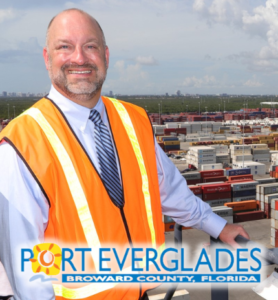Infrastructure Coalition Spotlight: Port Everglades
What does your business do in Florida?
Business diversity and a strong commitment to customer service distinguishes Port Everglades from most U.S. seaports. With its proximity to the popular Caribbean, Port Everglades is the third busiest cruise homeport in the world. It is a leading container port in Florida and among the most active cargo ports in the United States. Port Everglades is also South Florida’s main seaport for receiving energy products, including gasoline and jet fuel supplied to four international airports. Port customers benefit from direct highway access, an international airport within two miles, state-of-the-art foreign-trade zone warehousing and a 43-acre intermodal container transfer facility that makes it possible for cargo shipped to Port Everglades to reach Atlanta and Charlotte by rail within two days and 70 percent of the U.S. population in four days. The Port Everglades Department is a self-supporting Enterprise Fund of Broward County, Florida government and does not rely on local tax dollars for operations. The total value of economic activity related to Port Everglades exceeds $30 billion. More than206,000 Florida jobs are impacted by the Port, including 7,000 people who work for companies that provide direct services to Port Everglades.
How would you like to see Florida’s infrastructure improve by 2030?
While the Florida Department of Transportation is doing an excellent job supporting seaport advancements throughout the state, there is an immediate need to improve the state’s roadway system to take full advantage of driving goods into the marketplace. Truckers in South Florida, frustrated by traffic, create congestion at our ports by arriving too early at cargo terminals so that they can avoid congestion on the roadways. With Florida’s rapidly increasing consumer populations, improving roadways into key distribution markets should be a state priority.
Do you have any projects or advancements in progress you would like to highlight?
Construction is nearly completed on the largest infrastructure project in the Port’s history. The Southport Turning Notch Extension, slated for completion in late 2023, will add new cargo berths and Super Post-Panamax container gantry cranes to the Port’s main containerized cargo area by lengthening the existing turnaround area (turning notch) from 900 feet to 2,400 feet. Part of the $471 million project includes installing crane rail infrastructure to handle new Super Post-Panamax container gantry cranes and the Port’s existing cranes. The entire project is estimated to create 3,045 construction jobs and support 5,529 direct and indirect local/regional jobs.
Port Everglades commissioned three Super Post-Panamax container gantry cranes in 2021 at $13.8 million each to meet demands from current customers and new services anticipated from the Port’s multi-million-dollar expansion program. Three additional Super Post-Panamax container gantry cranes are under construction and anticipated to arrive in late 2023. The new cranes can load and unload ships with containers stacked nine high from the deck and reach 22 containers across to the ships outer rail.
In the Port’s energy sector, a $184-million Slip 1 expansion will allow the Port to safely service the petroleum industry with greater capacity, efficiency, sustainability, and resiliency. This is a public-private partnership, with the civil infrastructure being constructed by the Port and petroleum transfer infrastructure being installed by private partners. Port Everglades will reconstruct the slip, making it 150-feet wider to accommodate larger ships. The project is anticipated to be completed by 2025.
To further enhance ship traffic at Port Everglades, the U.S. Army Corps of Engineers (USACE) is advancing a 24-year plan to deepen the Port’s navigation channels from 42 feet to 48-50 feet and widen narrower sections of the channel for safe vessel passage. The USACE estimates the project will create a total of 2,222 direct and 2,567 indirect construction jobs. Construction is anticipated to be completed by 2030.